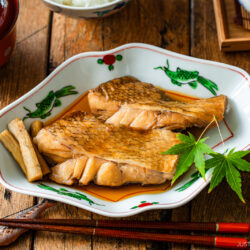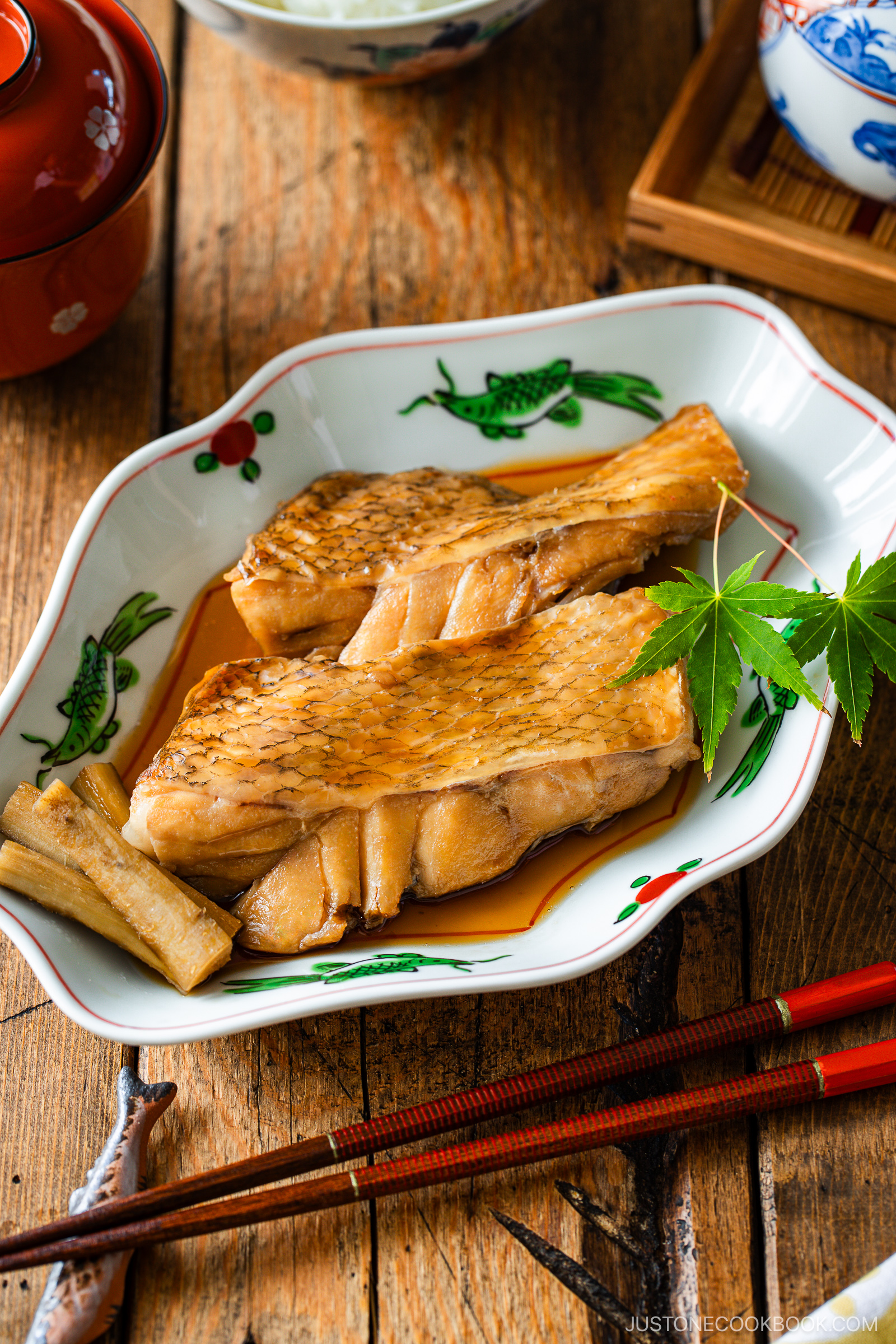
My family loves all types of fish dishes, including this delicious Nitsuke recipe. I used cod here, but you can use any type of fish with white flesh. I’ll teach you my tips and techniques for the most tender, moist, and sweet-savory braised fish that goes perfectly with any Japanese meal.
If you’re craving more Japanese fish recipes, try my Miso Cod, Teriyaki Salmon, and Grilled Mackerel next!
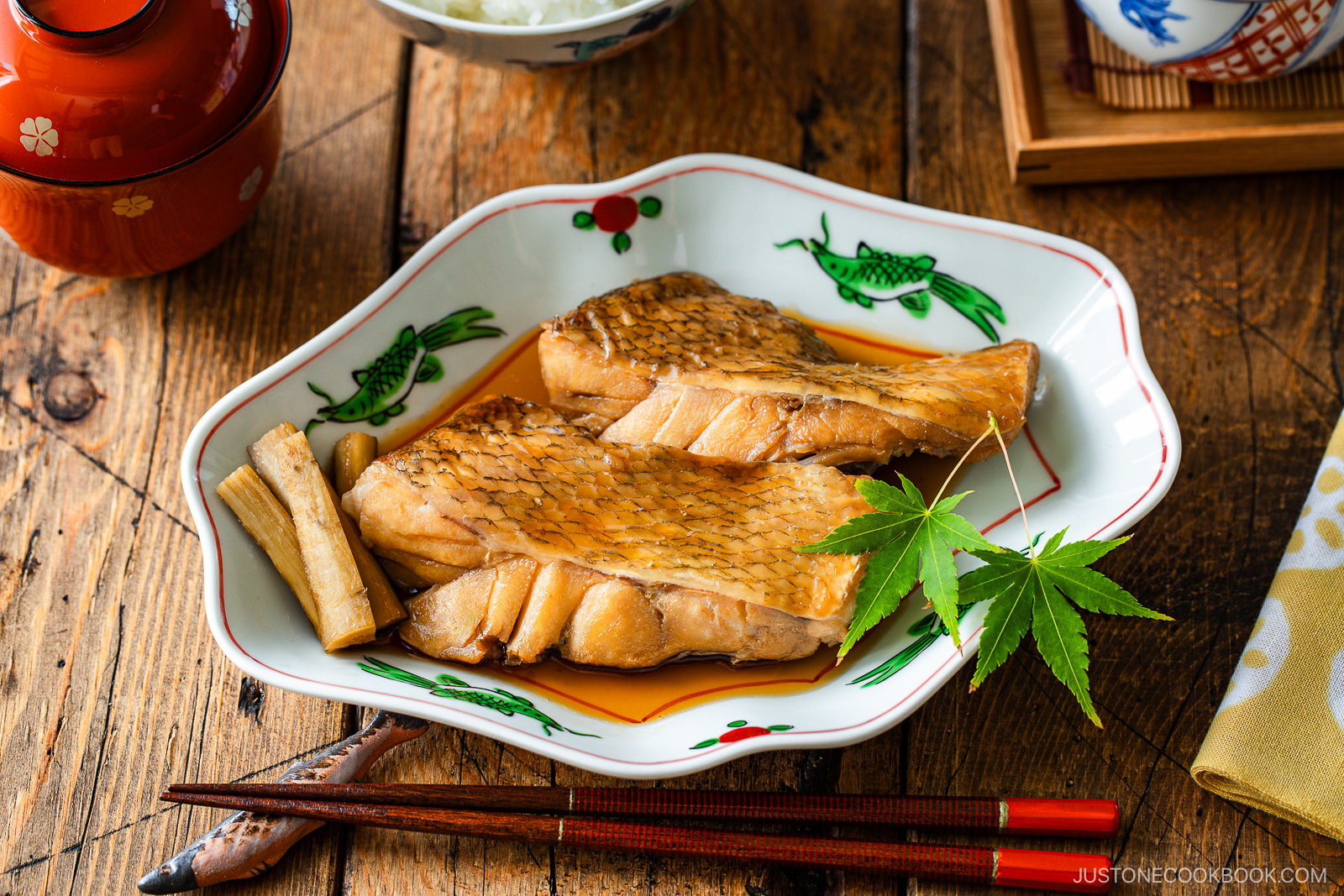
What is Nitsuke?
Nitsuke (煮付け) is a traditional Japanese simmered dish, typically made with fish or root vegetables gently braised in a sweet-savory broth of soy sauce, sake, mirin, sugar, and often dashi (Japanese soup stock).
Originally developed to reduce fishy odors and preserve ingredients before refrigeration, nitsuke is now cherished for its deep flavor and glossy finish. After simmering, the fish or vegetables are now cooled in the cooking liquid to soak up even more umami-rich taste.
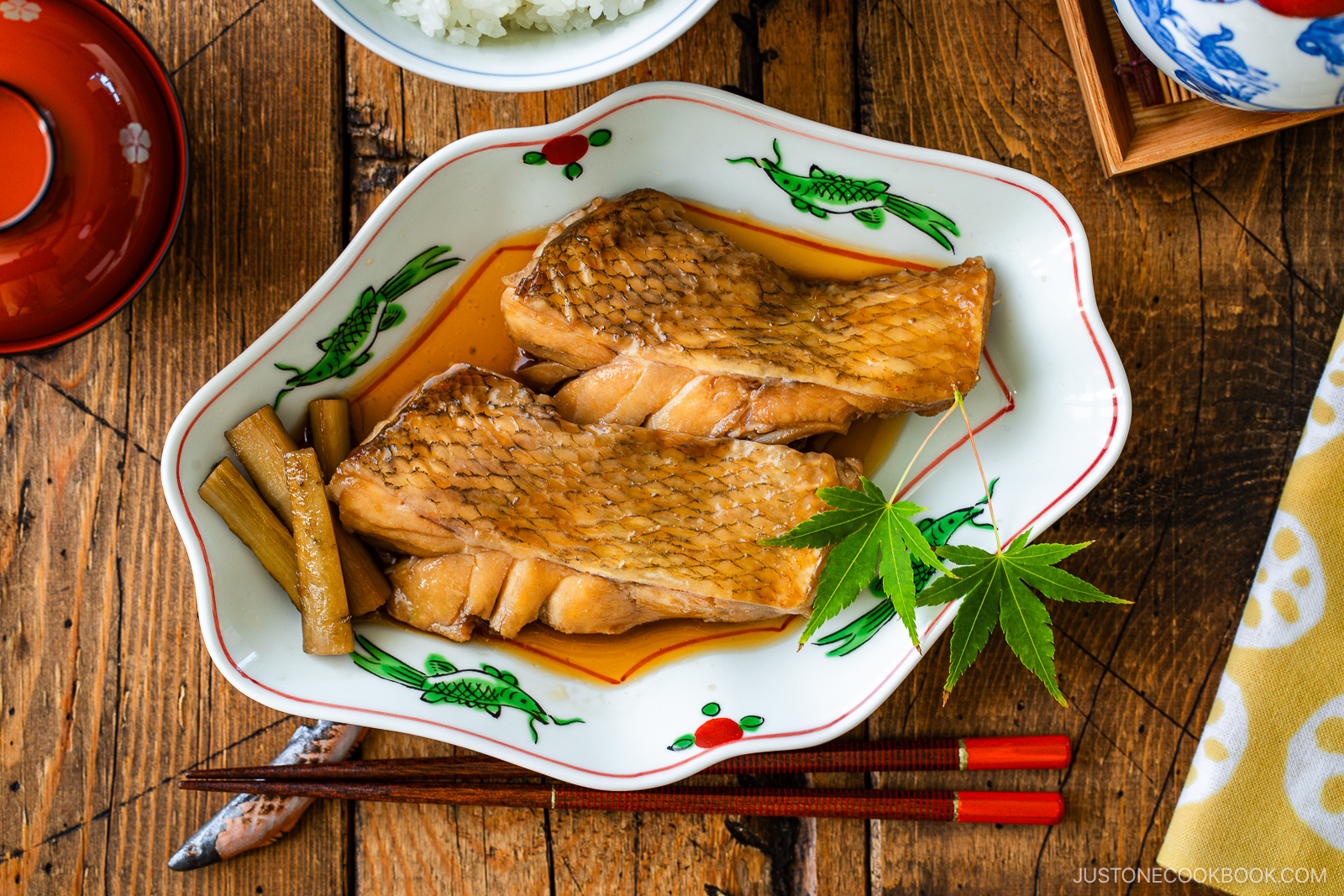
Ingredients for Nitsuke
- cod fillets – with skin
- kosher salt – helps draw out excess moisture and reduce the fishy odor before cooking
- gobo (burdock root)
- Seasoned broth:
- sake
- mirin
- soy sauce
- sugar
- water and kombu (dried kelp)
Find the printable recipe with measurements below.
Jump to RecipeKey Equipment
- otoshibuta (drop lid) – Find one on Amazon or learn how to make otoshibuta at home with aluminum foil.
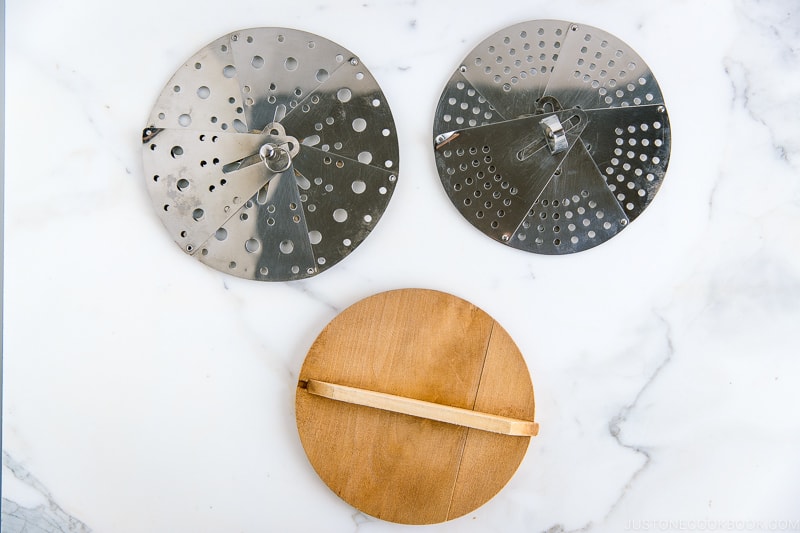
How to Make Nitsuke
Preparation
- Sprinkle salt on both sides of the fish. After 10–15 minutes, wipe dry with paper towels.
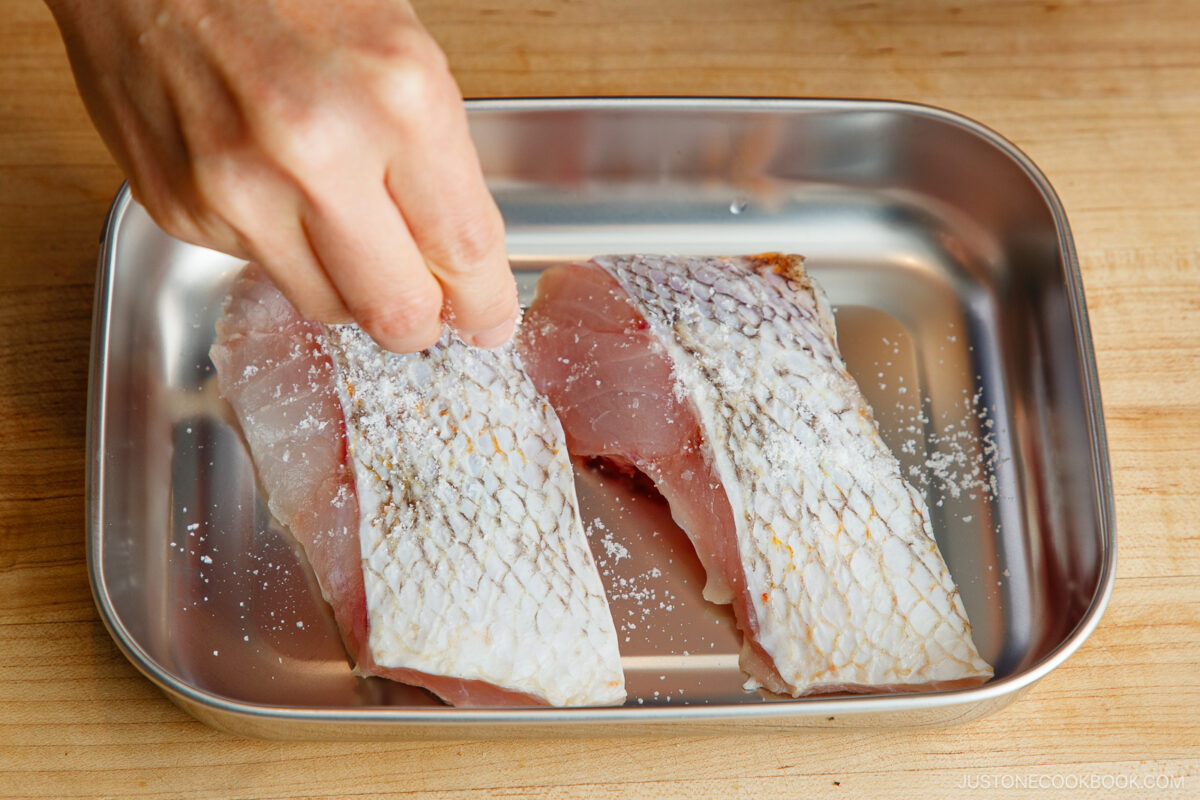

- Prep the ingredients. Meanwhile, soak the kombu in water, cut and soak the burdock root, and slice the ginger.
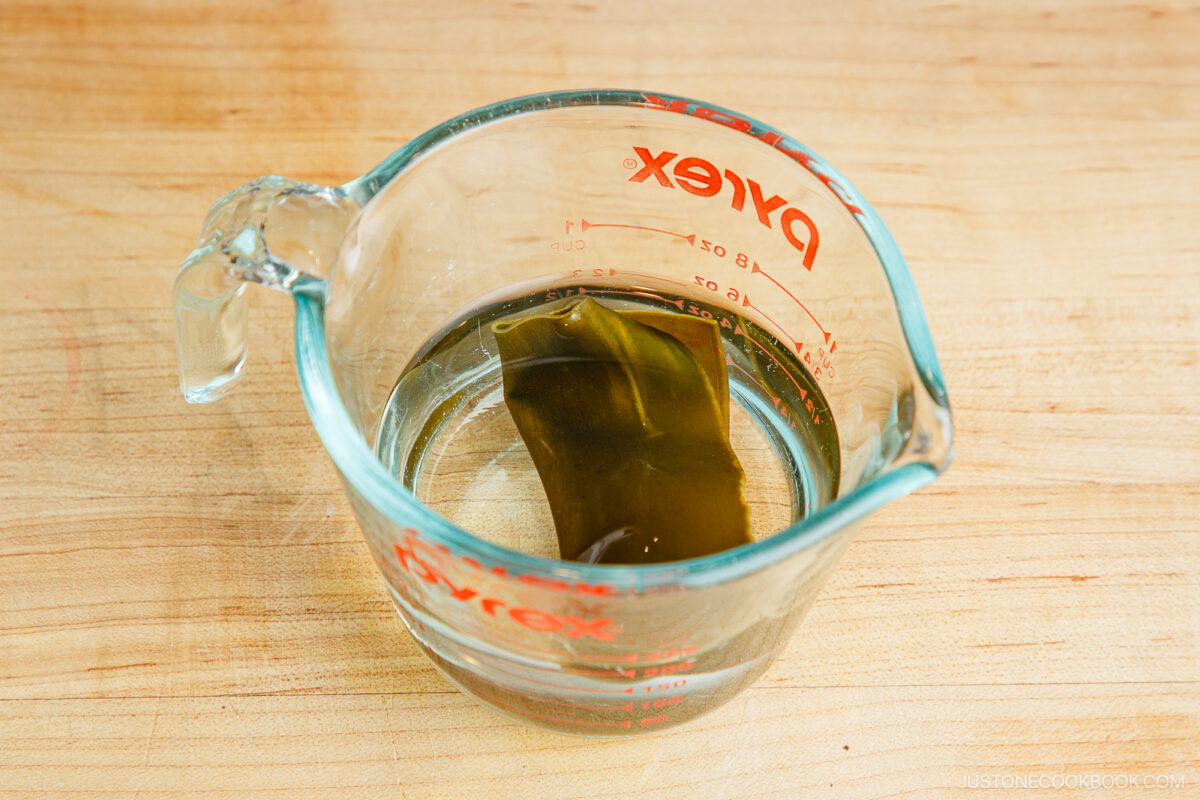
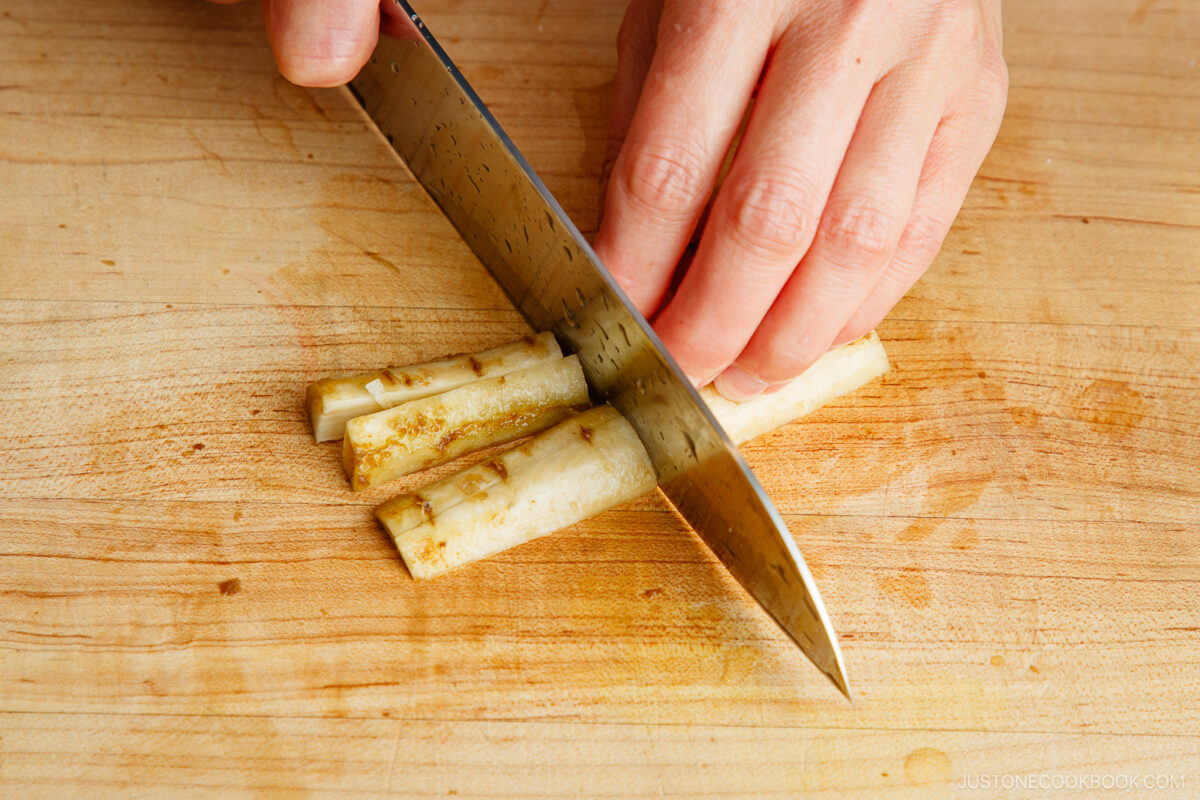
- Blanch the fish in just boiled water for 15–20 seconds. When the flesh turns white, remove and cool for 10 seconds in a bowl of ice water. Pat dry.
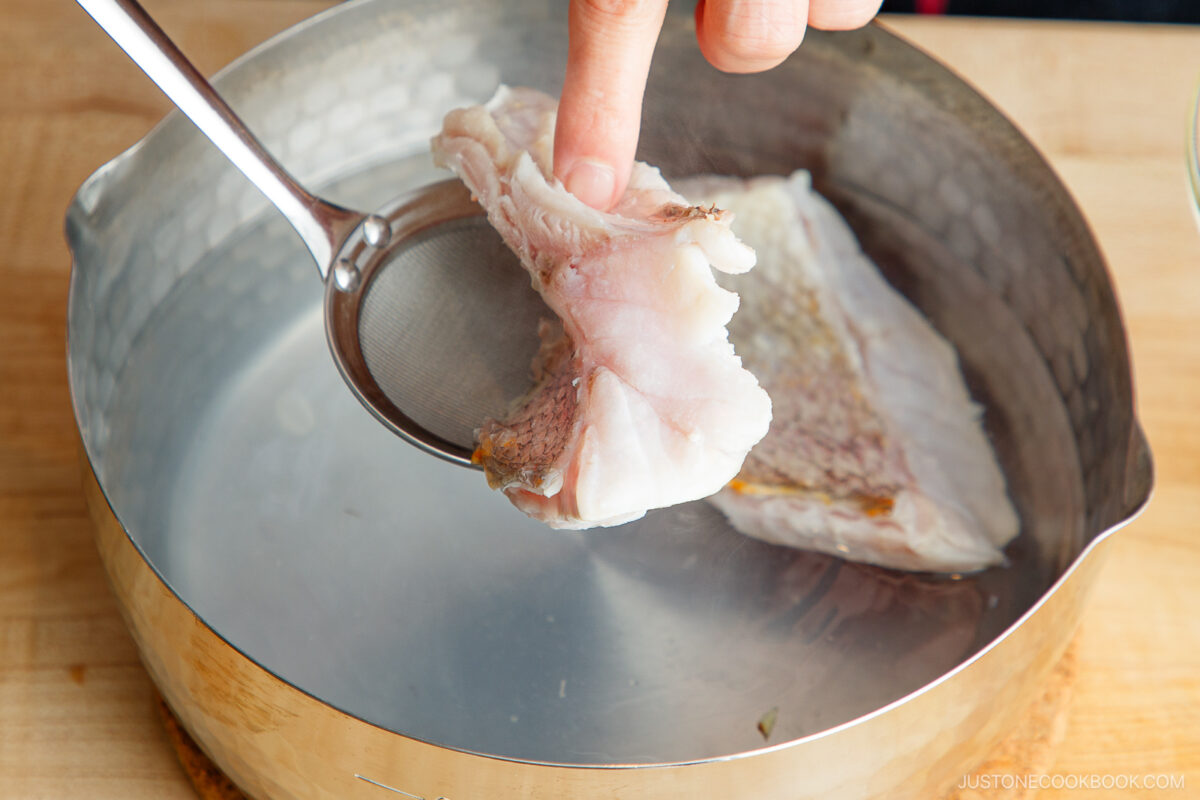
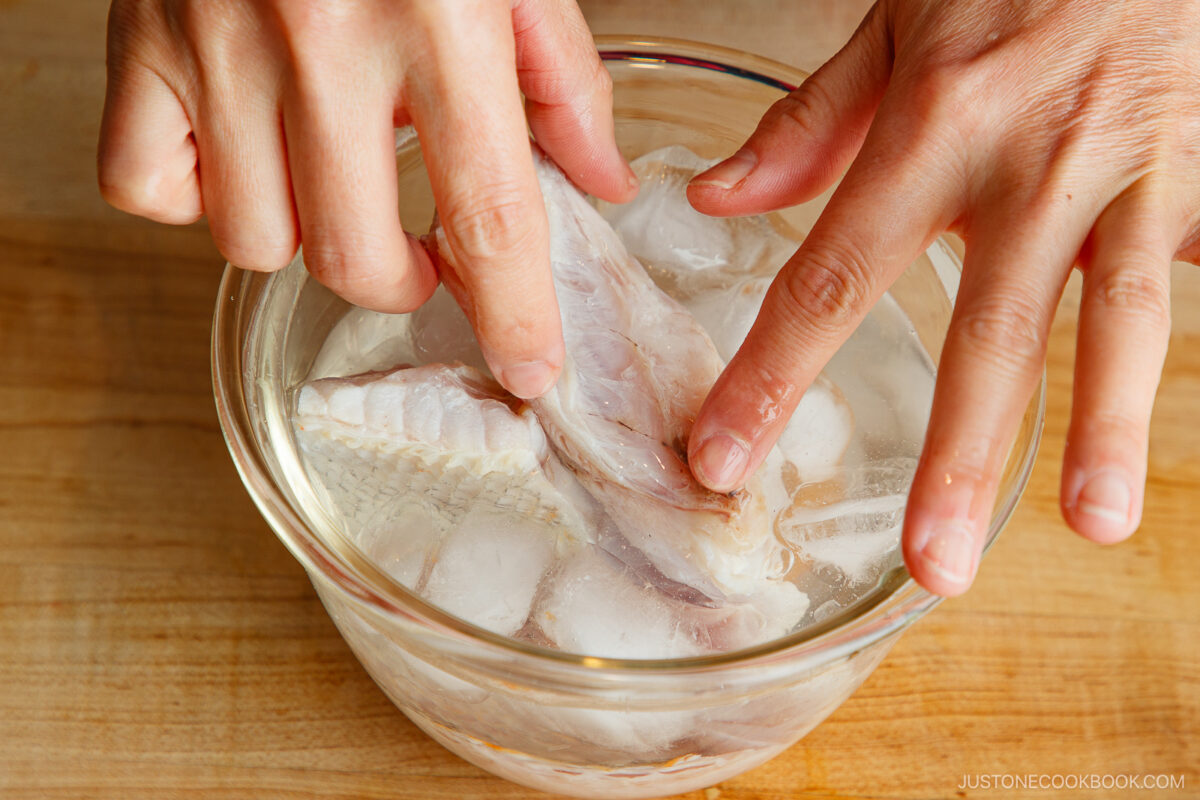
Cooking
- Gently boil the fish with water, kombu, and sake over medium heat. Add the burdock root and continue to cook. Skim the scum when boiling. Remove the kombu.
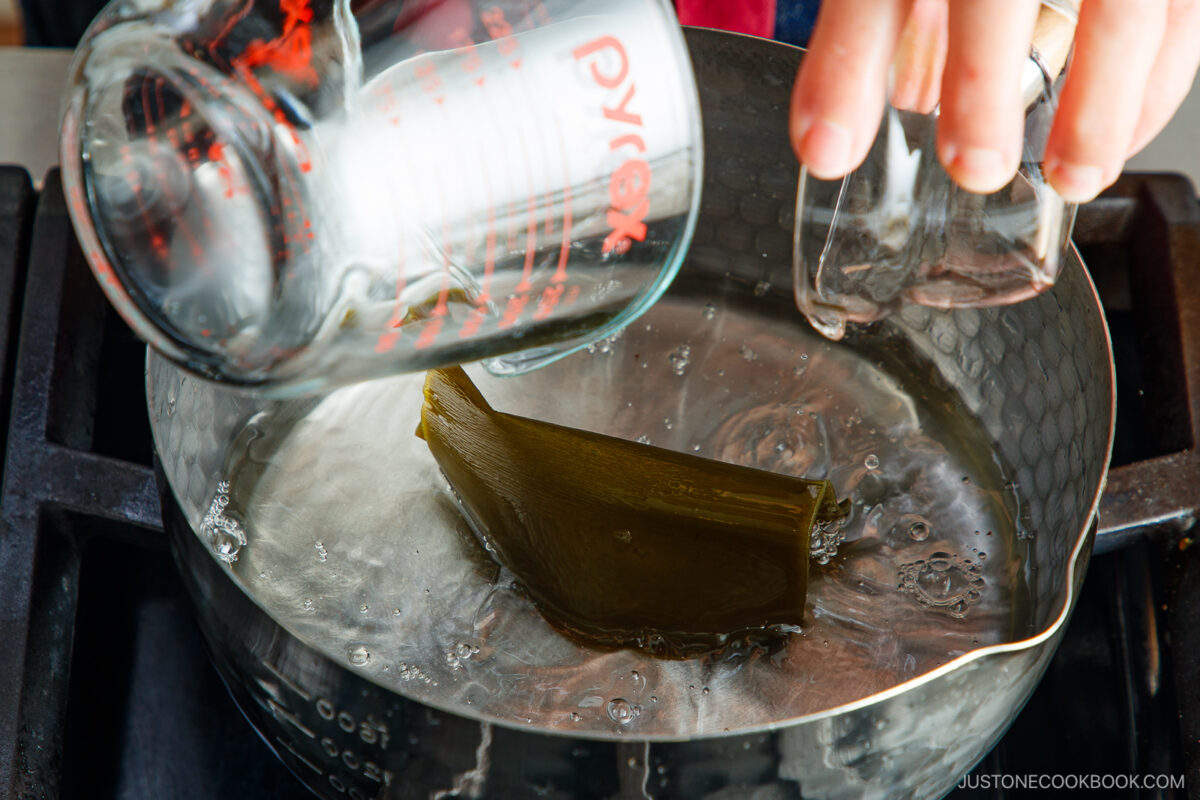
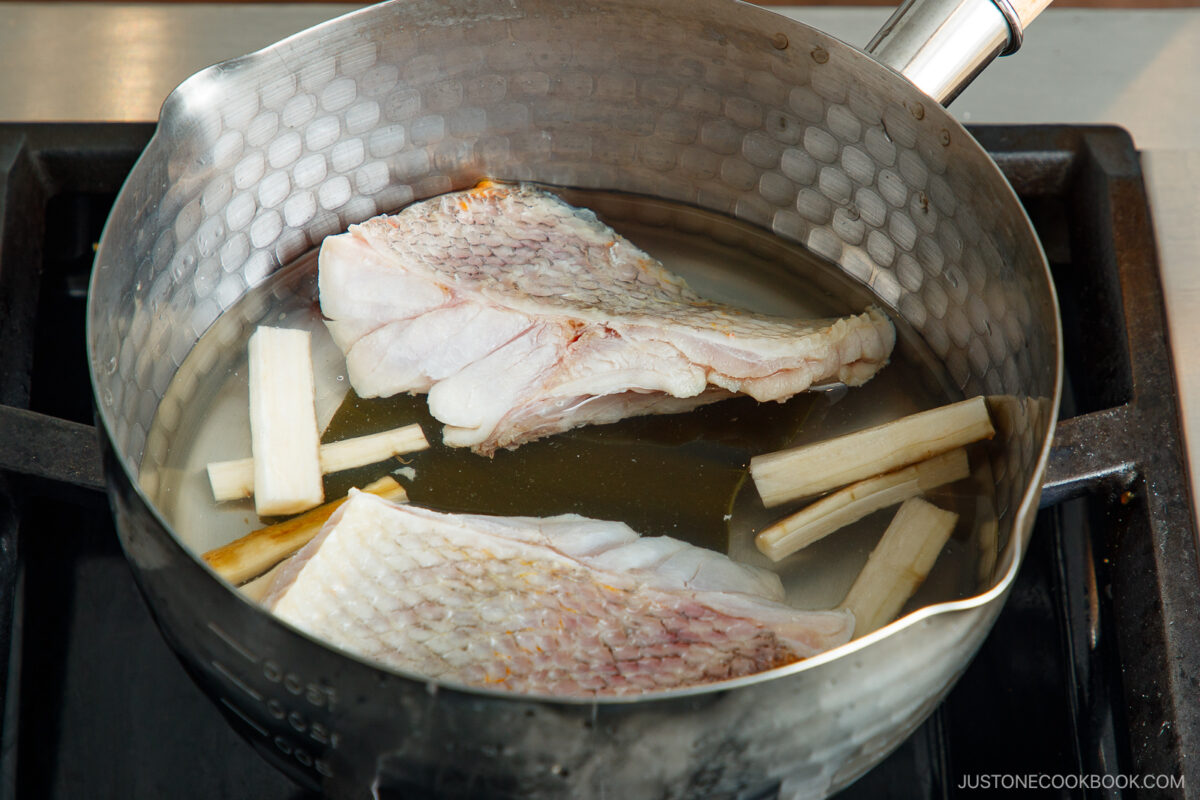
- Add the ginger, mirin, and sugar. Place a drop lid on top of the fish, reduce the heat, and simmer gently for 10 minutes.
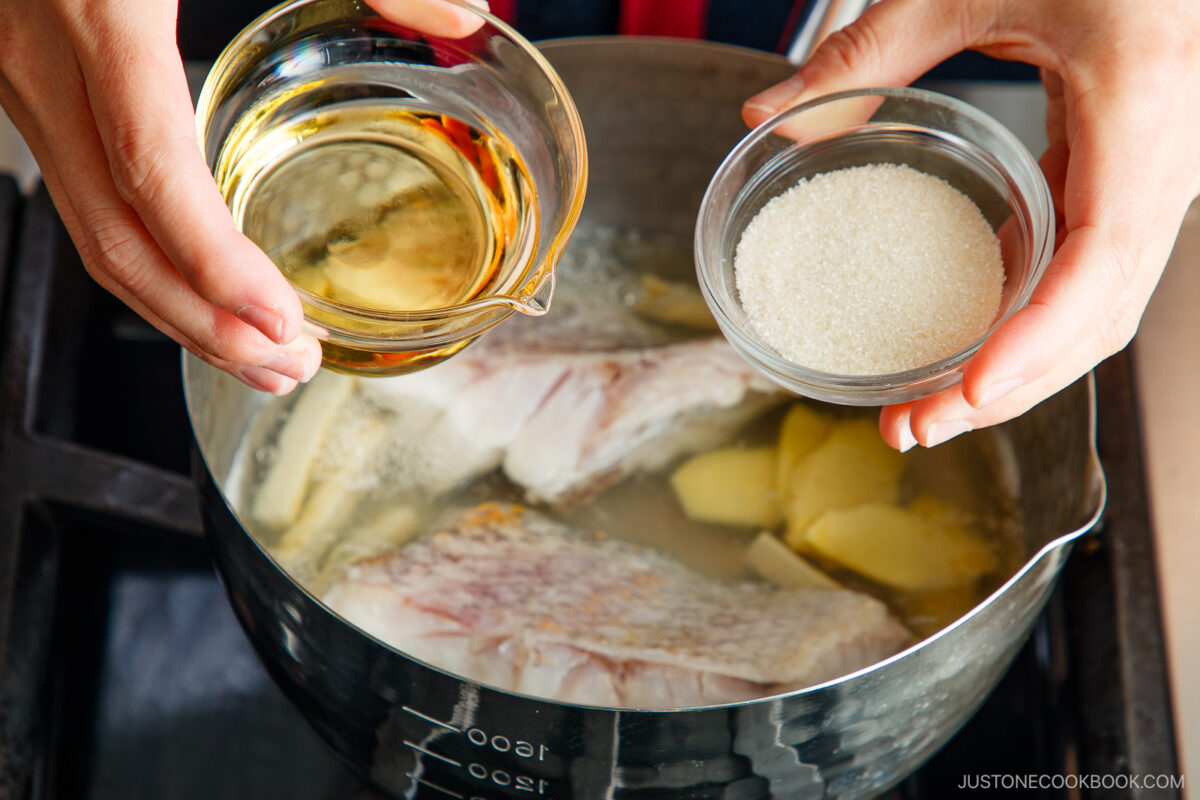
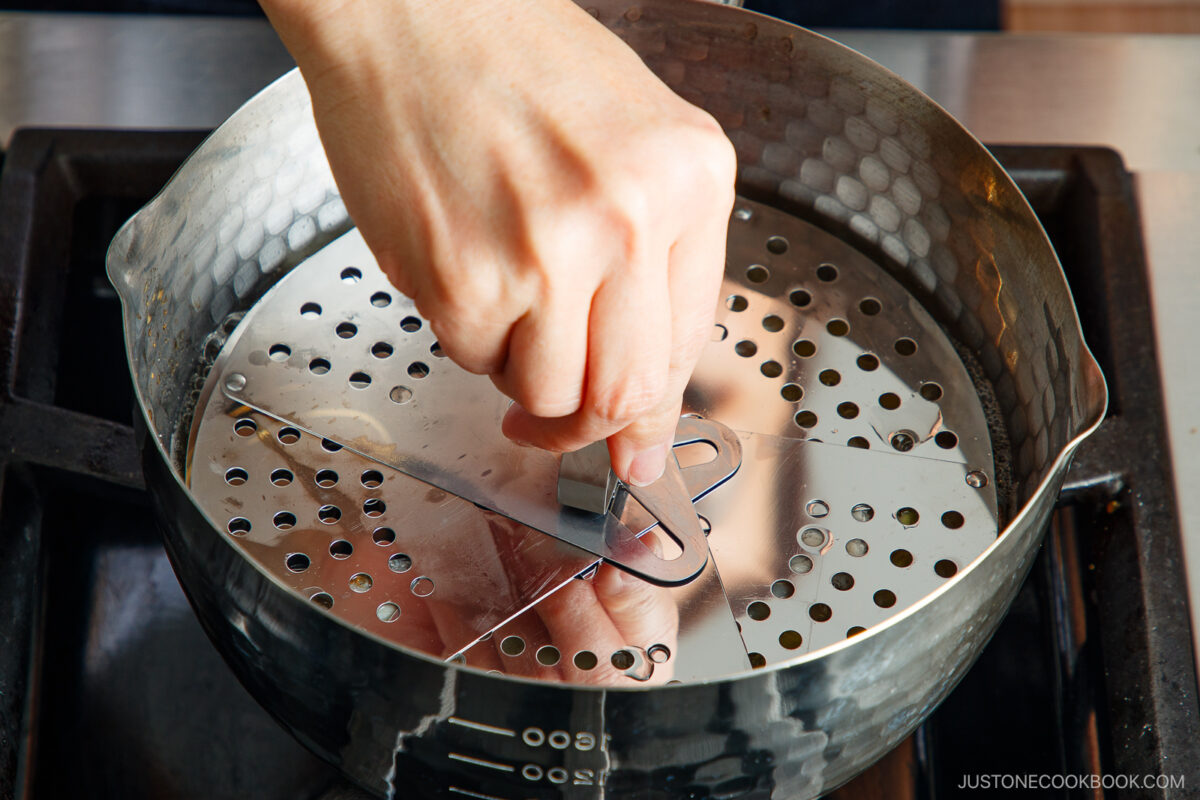
- Add soy sauce after 5 minutes (halfway cooking) and continue to simmer, occasionally spooning the cooking liquid over the fish.
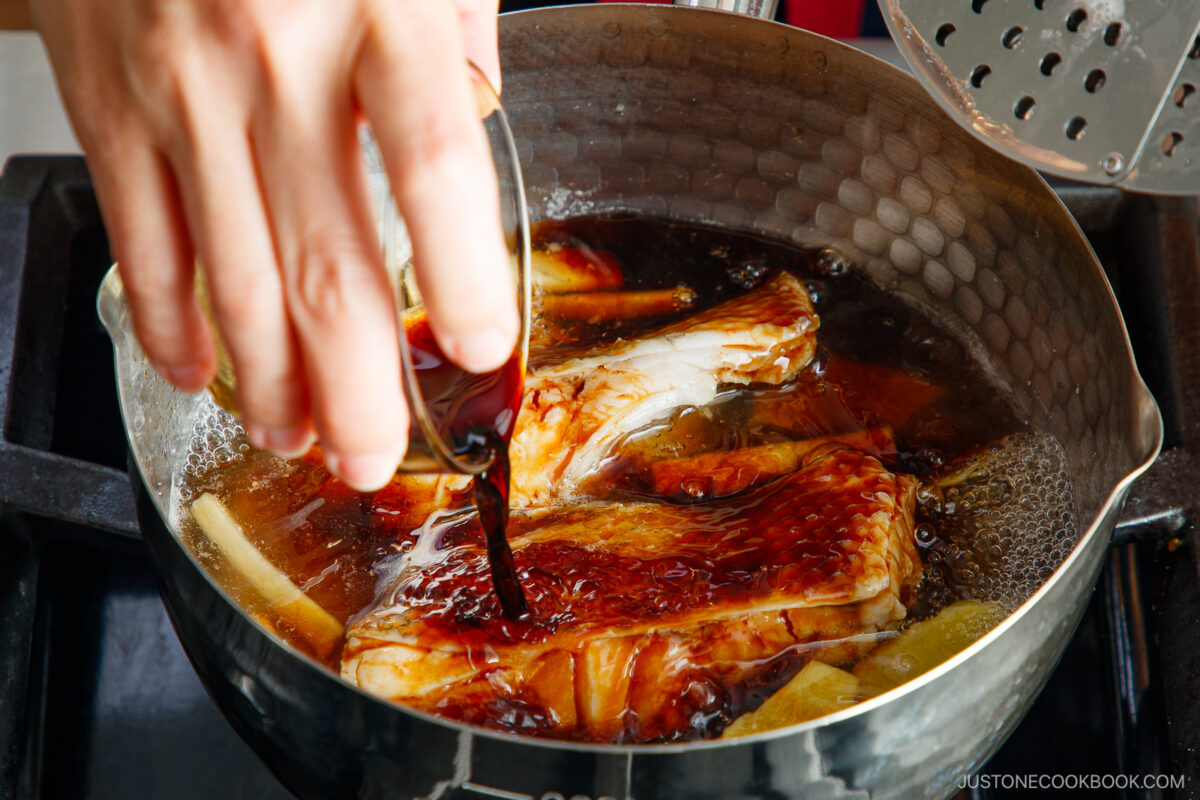
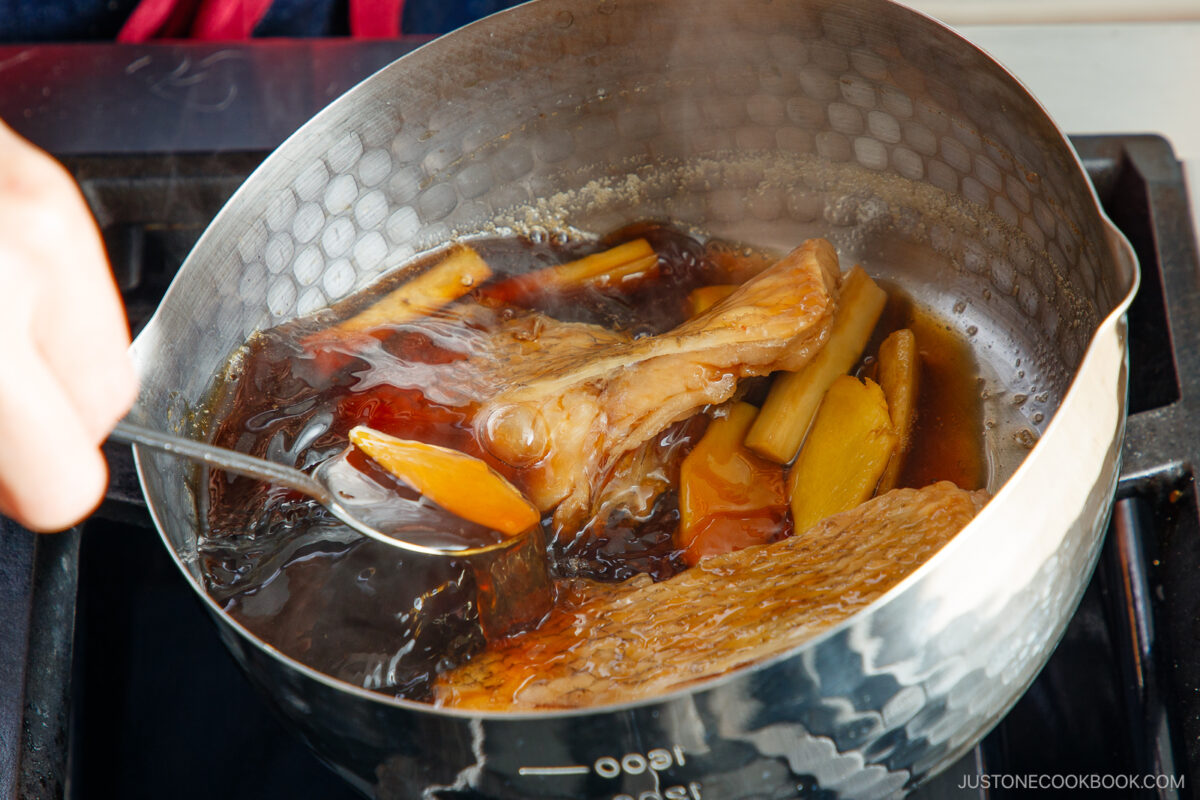
Cooling
- Cool completely in the broth to add moisture back into the fish and infuse it with more broth seasonings. Serve the fish and gobo on individual plates and spoon sauce on top.
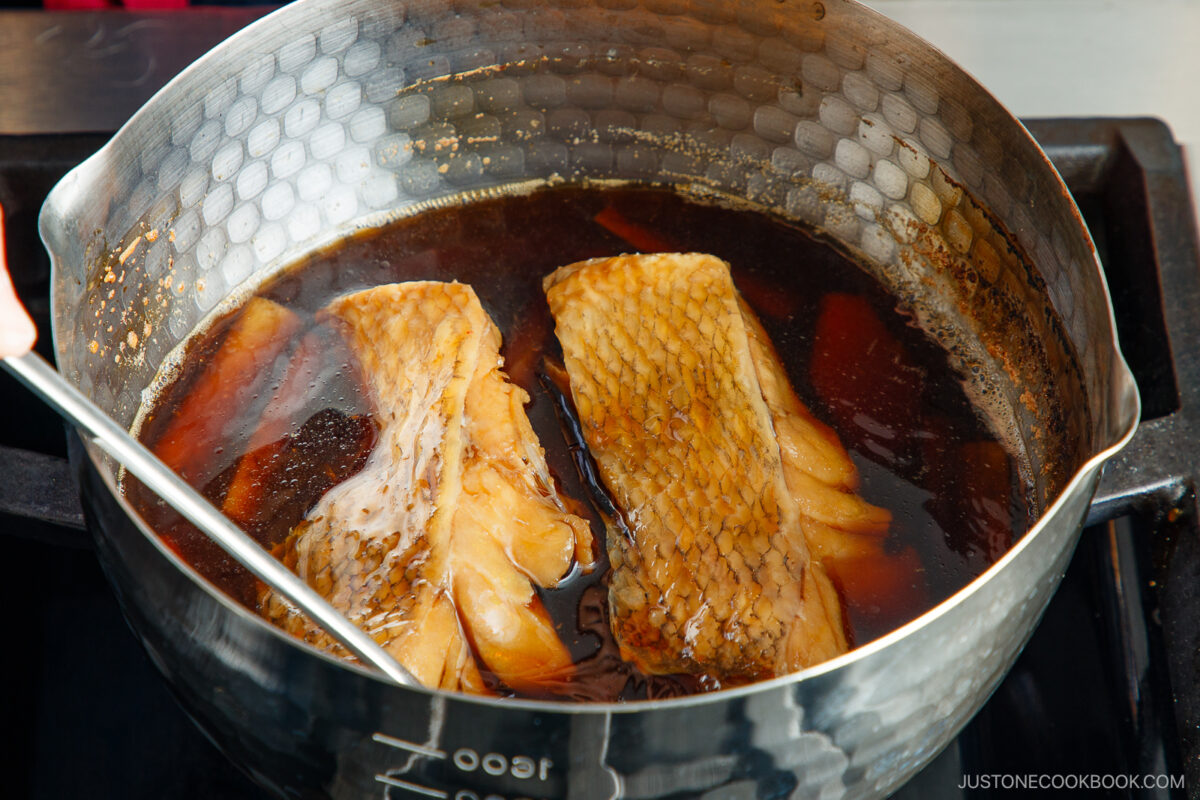
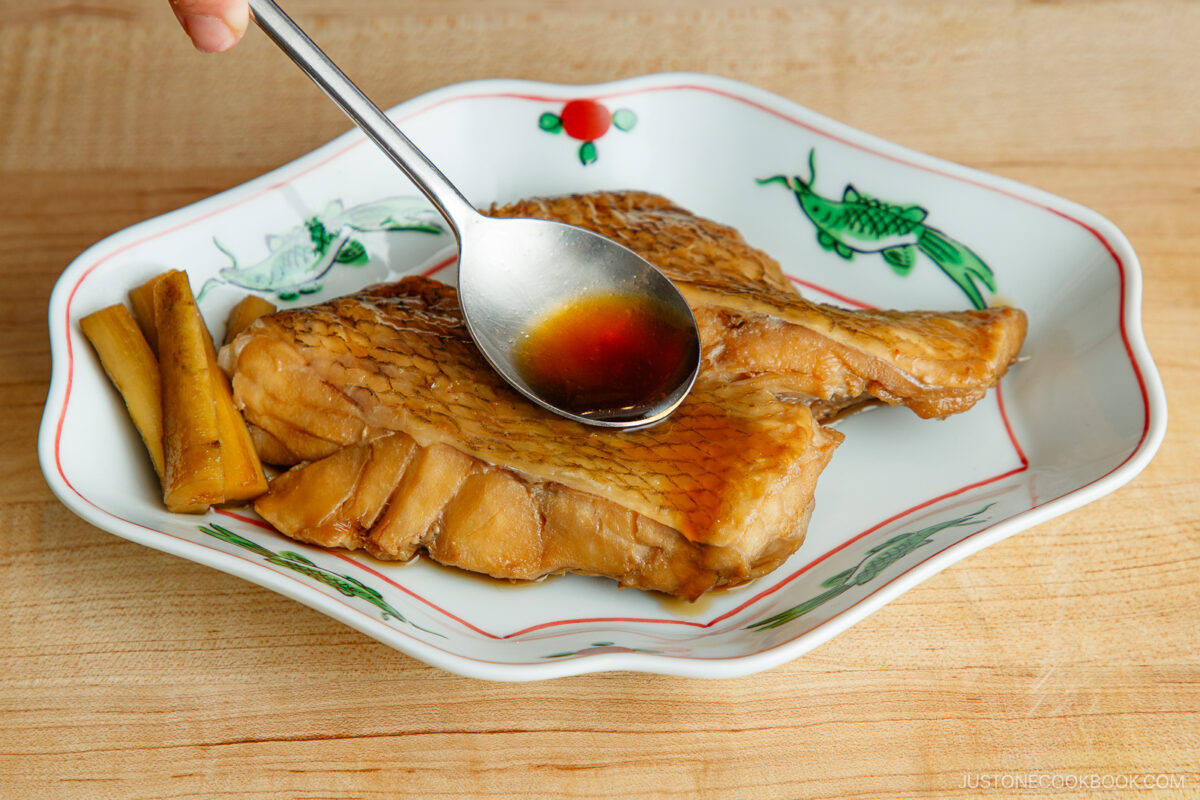
Nami’s Recipe Tips
- Use skin-on fillets so the fish doesn’t fall apart during cooking.
- Salt the fish fillets before blanching to draw out excess moisture and reduce any unwanted fishy odors.
- Blanch the fish briefly to remove odors and impurities for a clean, delicate sauce. Just 15–20 seconds is all it takes.
- Dunk in ice water for 10 seconds and rinse the blanched fish.
- Skim off the scum and debris from the broth’s surface with a fine-mesh skimmer. This quick step keeps the sauce clear.
- Use a drop lid on the fish to keep it from fall apart, retain moisture, and circulate the seasoned broth all around.
- Watch for evaporation and add a bit of water if the sauce gets low.
- Cool the fish in the broth so it absorbs moisture released during cooking as well as maximum flavor.
- Make it ahead if you have the time several hours in advance or the day before. It tastes even better the next day!
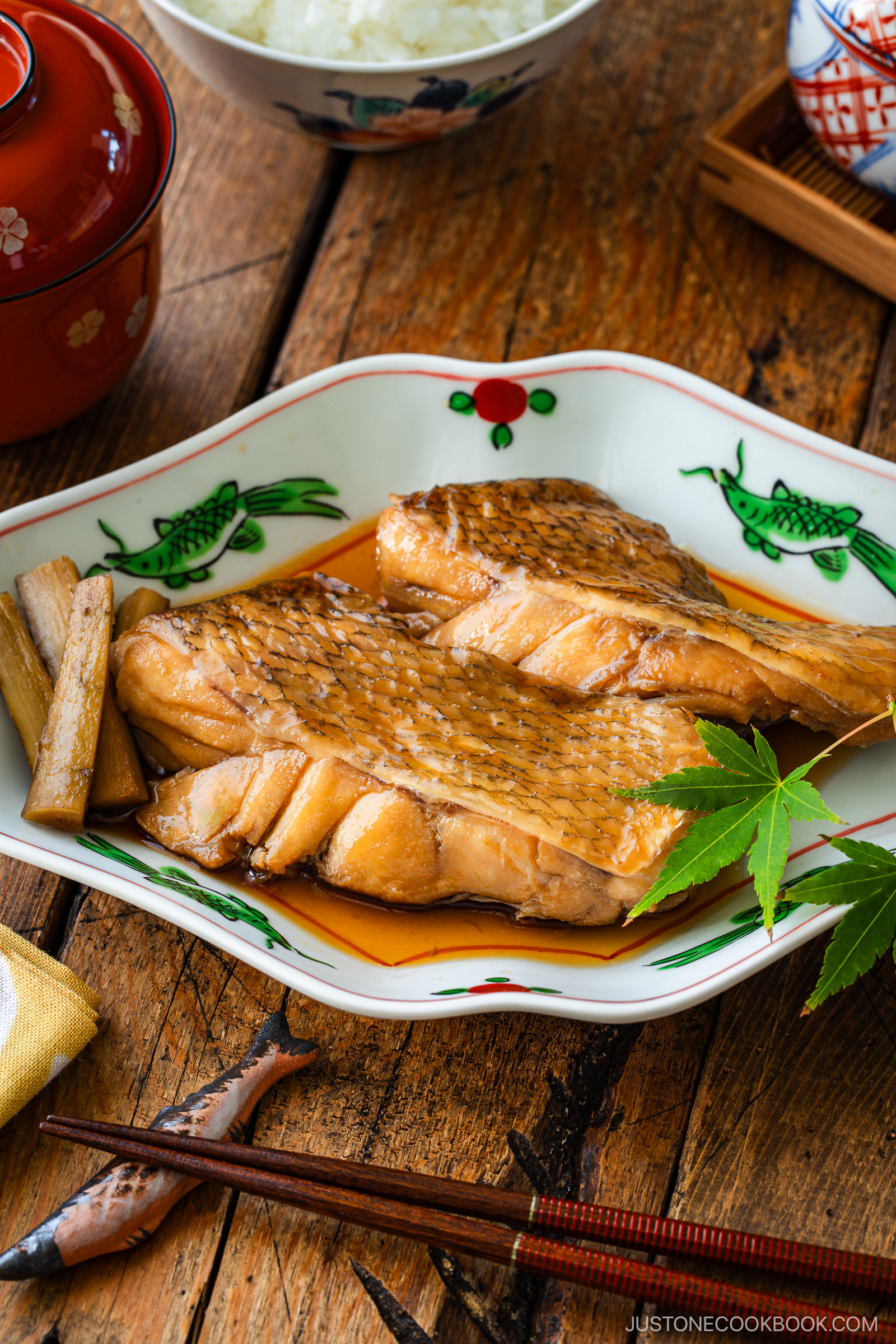
Variations and Customizations
- Adjust the soy sauce and sugar. Add more soy sauce for a stronger flavor and more sugar for a sweeter profile.
- Use a different white-flesh fish. Try yellowtail (buri), alfonsino (like my Kinmedai Nitsuke), black cod (gindara), flounder (karei), rockfish (mebaru), or snapper.
- Try it with tofu. Use this same technique to make simmered tofu.
- Add vegetables. If you don’t have burdock root, add lotus root, daikon, konnyaku, and taro, or add snow peas, green beans, or another sturdy green vegetable during the last few minutes of cooking.
What to Serve with Nitsuke
- Soup – Homemade Miso Soup
- Salad – Japanese Cucumber Salad (Sunomono)
- Side dish – Japanese Spinach Salad with Sesame Dressing (Gomaae)
- White rice – How to Cook Japanese Rice in a Pot on the Stove
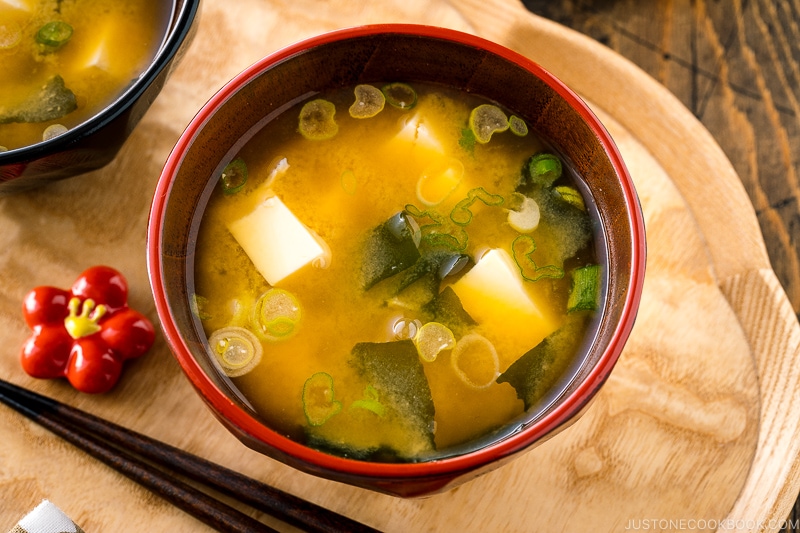
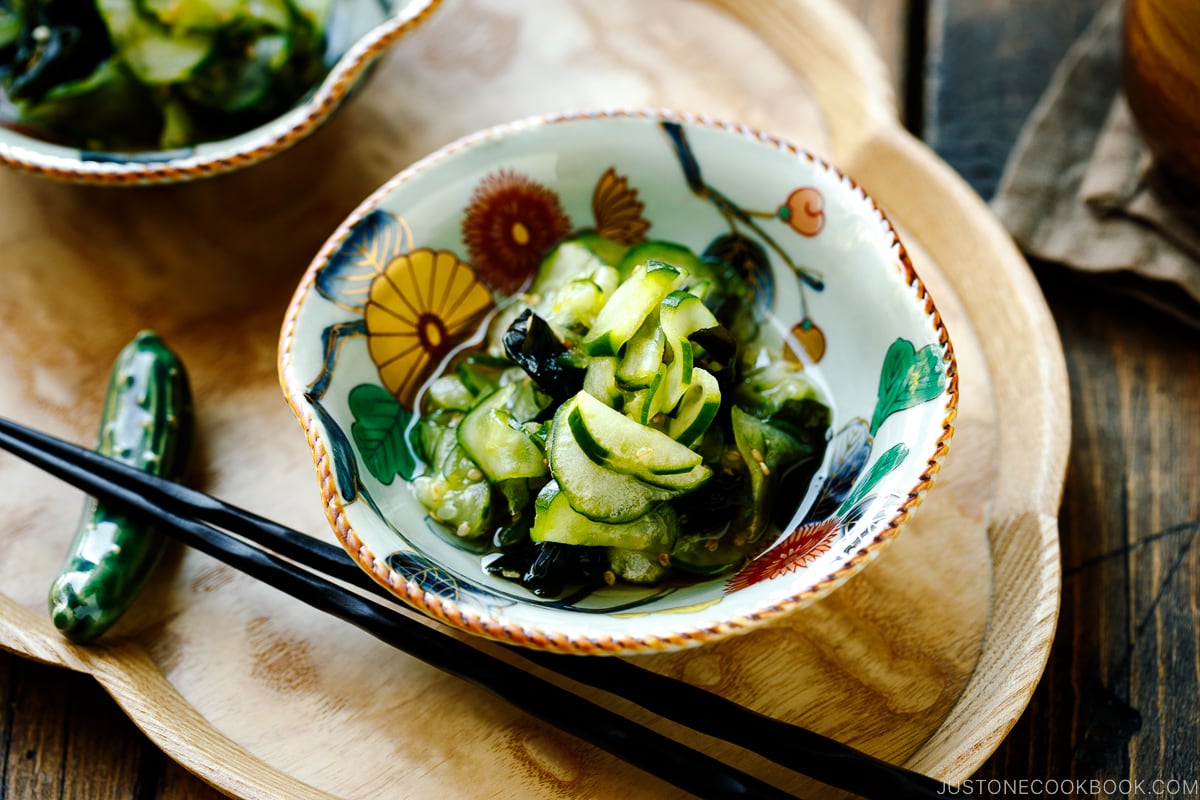
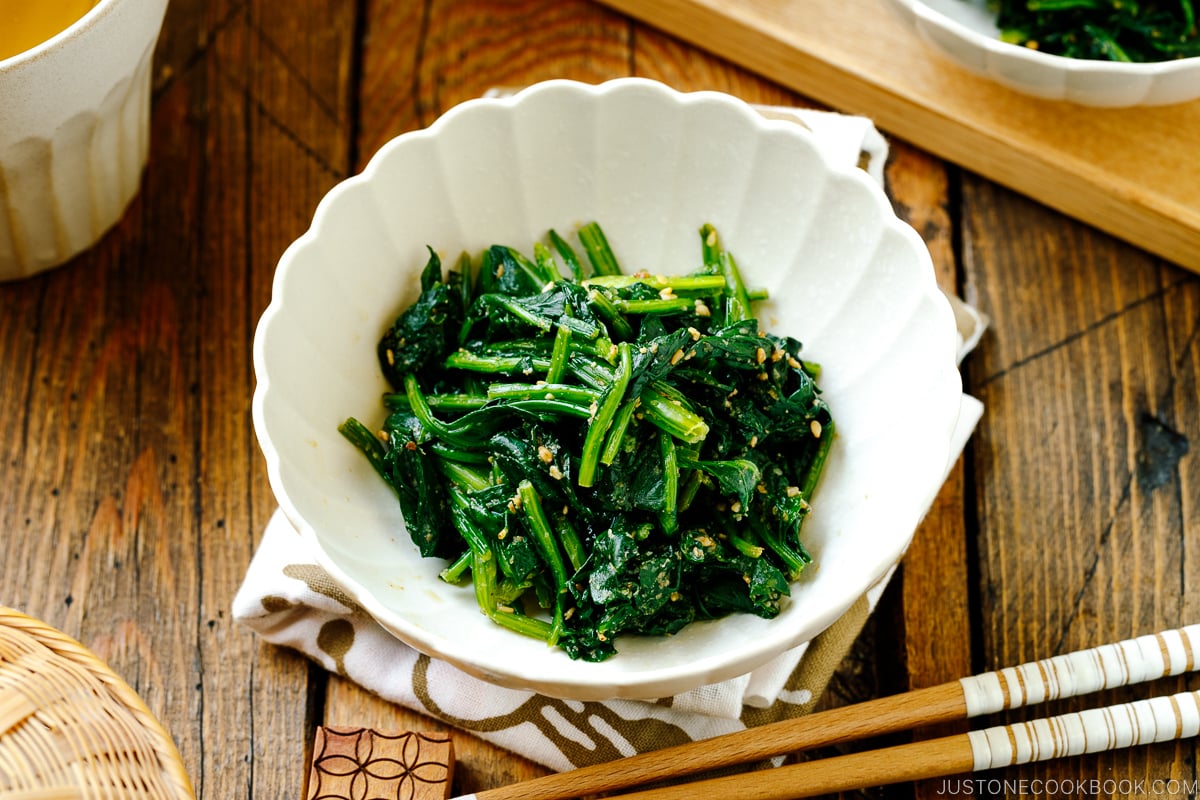
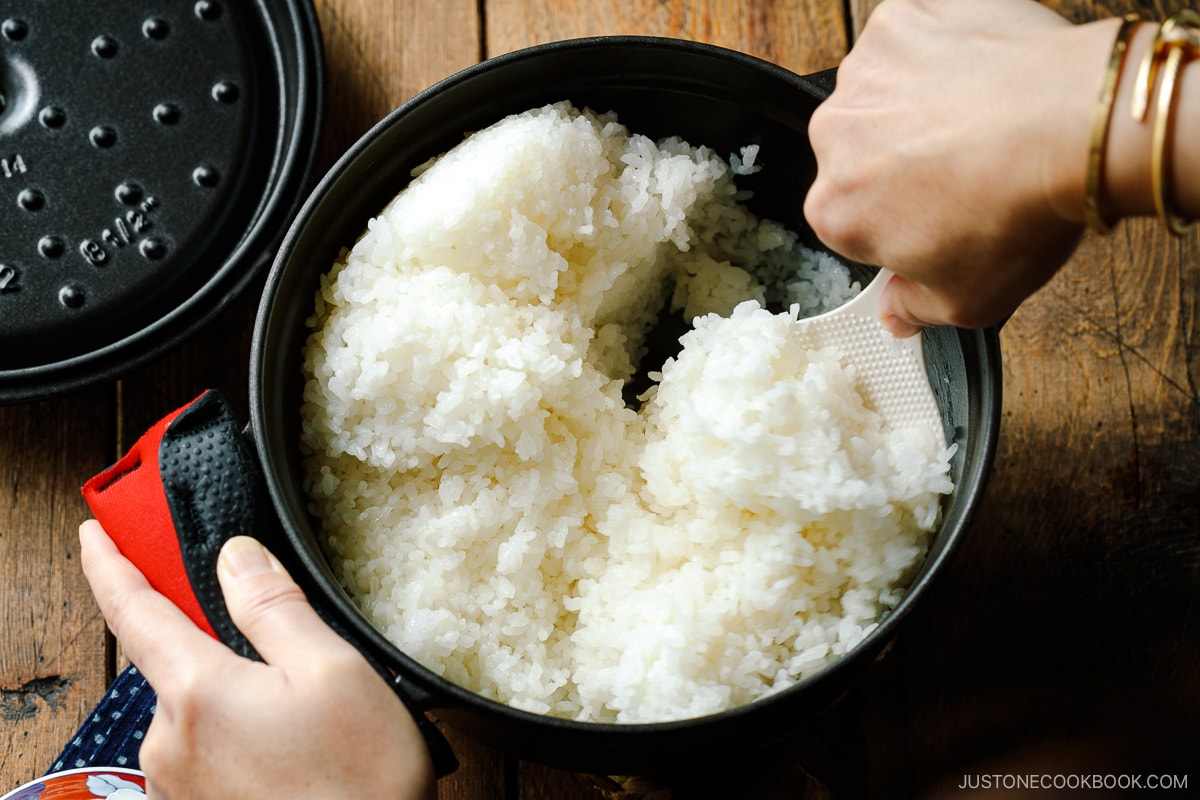
Storage and Reheating Tips
To store: Once completely cooled, transfer the leftovers to an airtight container and store in the refrigerator for up to 2–3 days or in the freezer for up to a month.
To reheat: Gently reheat in a pot with seasoned broth until warm.
Nitsuke Recipe (Japanese Simmered Fish)
Ingredients
- ½ lb cod fillet portions (about 2 small fillet portions in the photo; skin on; or use another white flesh fish; see my suggestions in the blog post)
- ⅛ tsp Diamond Crystal kosher salt (about 2 pinches)
- 3 inches gobo (burdock root)
- 1 knob ginger (1½ inches, 3.8 cm)
For the Simmering Broth
- ¾ cup water
- 1 piece kombu (dried kelp) (2 x 3 inches, 5 x 7.6 cm, 6 g per piece)
- ¼ cup sake
- ¼ cup mirin
- 1½ Tbsp sugar
- 3 Tbsp soy sauce
Instructions
- Gather all the ingredients.
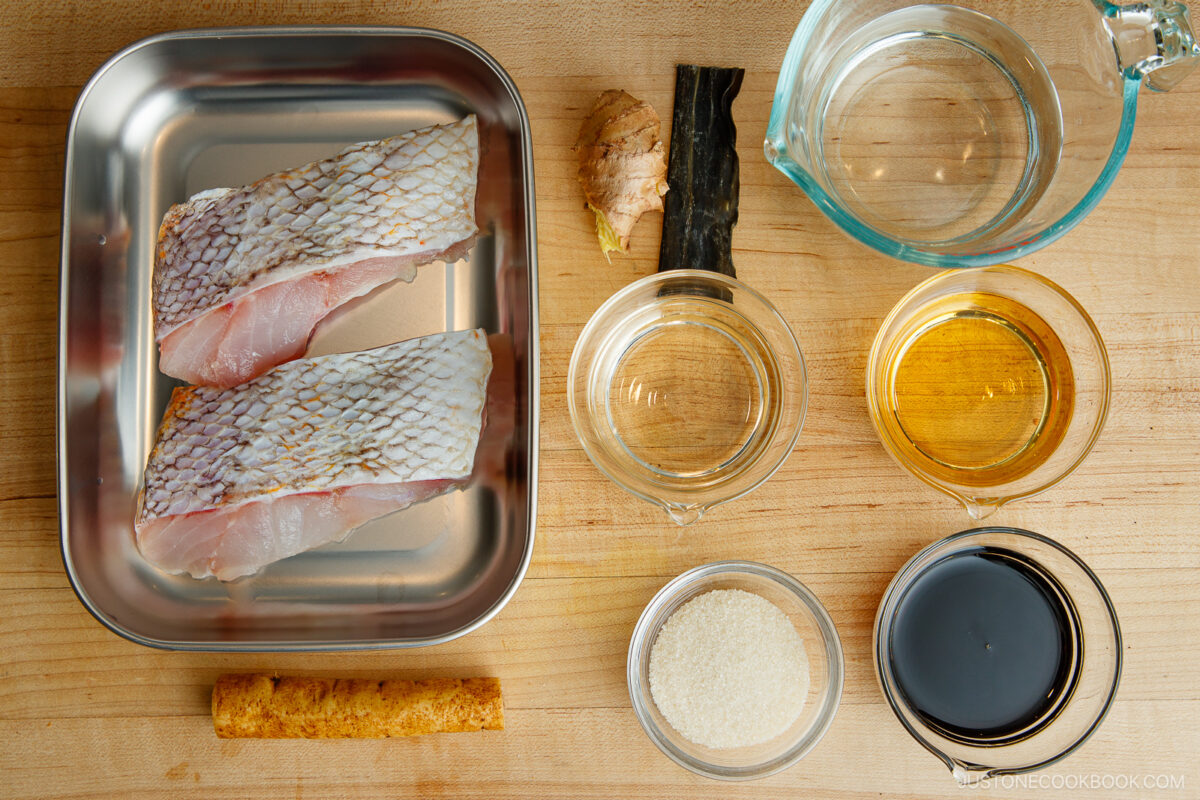
To Prep the Ingredients
- To start the kombu dashi, place ¾ cup water in a measuring cup and add 1 piece kombu (dried kelp). Allow it to steep to release flavor (this is cold brew kombu dashi). In the meantime, prepare the other ingredients.
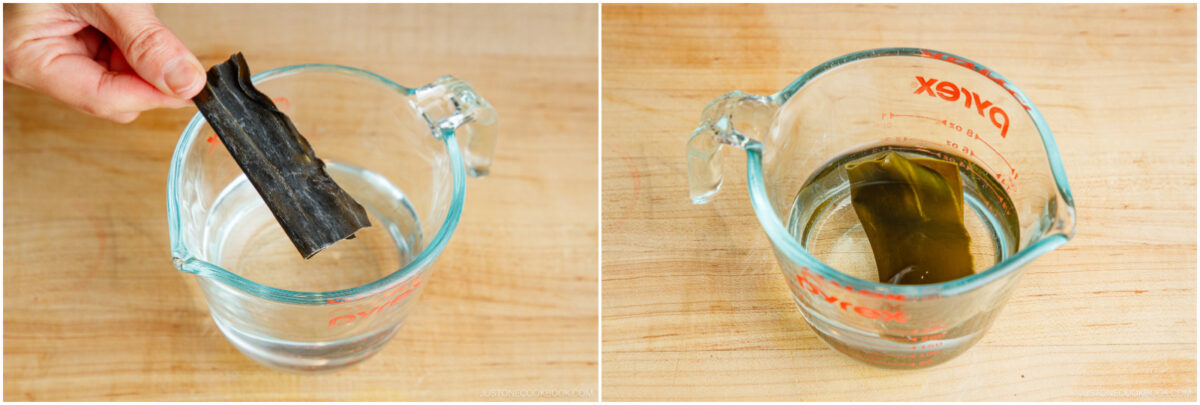
- Place ½ lb cod fillet portions on a tray; I used my favorite stainless prep tray. Sprinkle ⅛ tsp Diamond Crystal kosher salt on both sides, including the skin, and let sit for 10–15 minutes. Nami's Tip: This step isn't for seasoning—just a light pinch of salt per fillet (about 4 oz or 113 g) is enough. Salting draws out excess moisture and helps remove fishy odor. Don't skip it! Too much salt can make the fish tough, so go light.
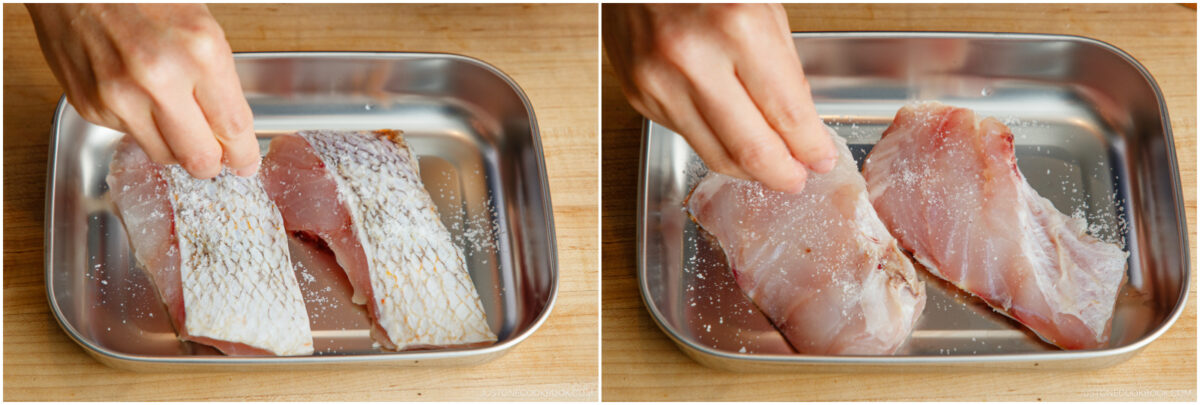
- Meanwhile, scrape the skin off 3 inches gobo (burdock root) with the back of a knife. Cut the gobo into thin slices lengthwise.

- Next, cut the slices in half crosswise. Soak in water for 5–10 minutes to remove bitterness and prevent discoloration. Change the water halfway. Drain and rinse.
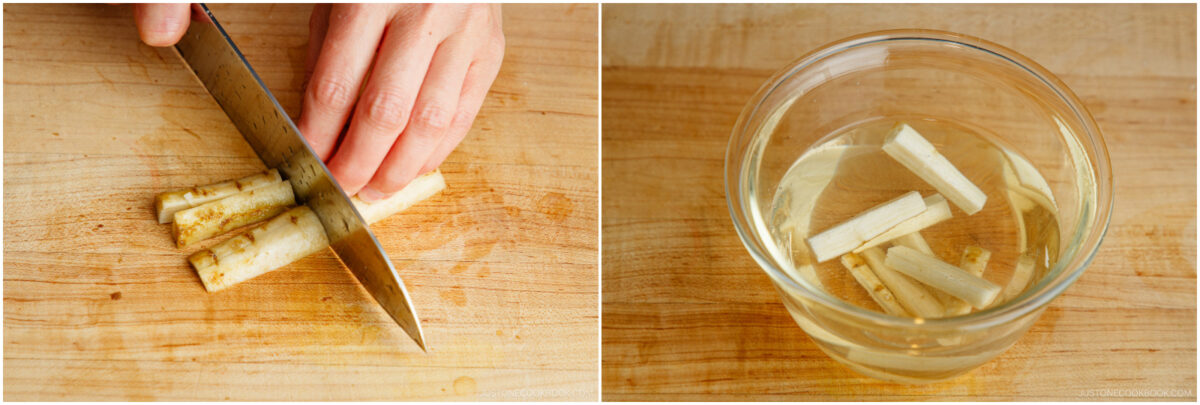
- Peel 1 knob ginger and cut it into thin slices.
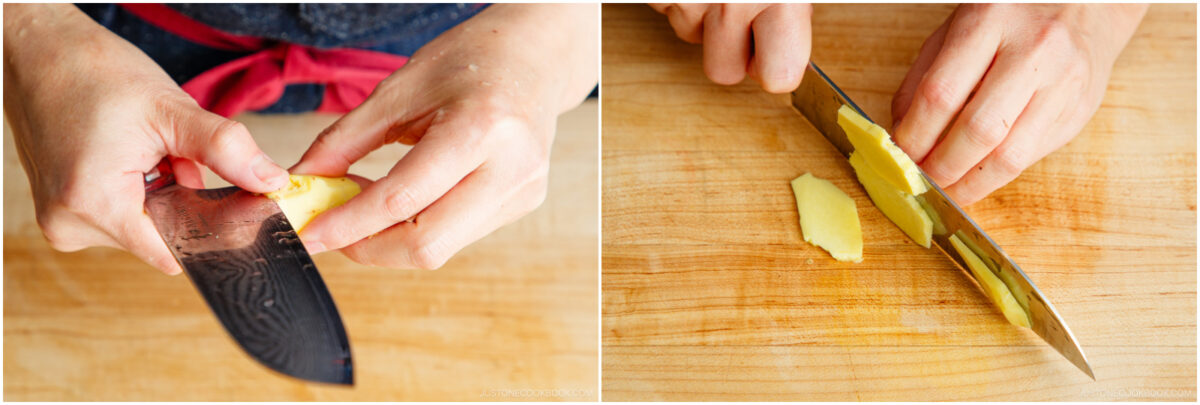
To Blanch the Fish
- After 10–15 minutes, you'll notice moisture on the surface of the fish. This liquid holds the fishy smell. Gently pat the fillets dry with paper towels.
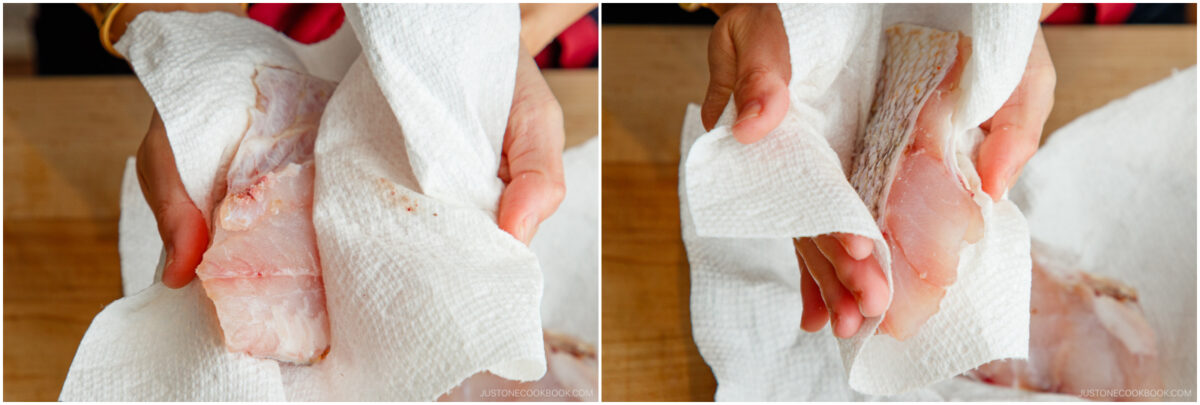
- Boil just enough water in a medium saucepan to cover the fish. While waiting, prepare a medium bowl of cold water with several ice cubes. Once the water comes to a boil, turn off the heat. Gently add the fish and blanch for 15–20 seconds.
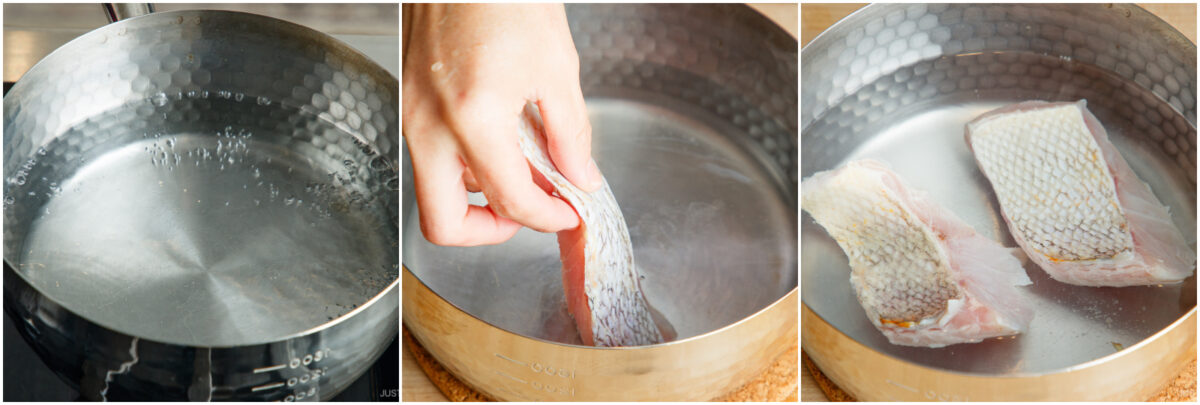
- Halfway through, gently flip over the fillets.
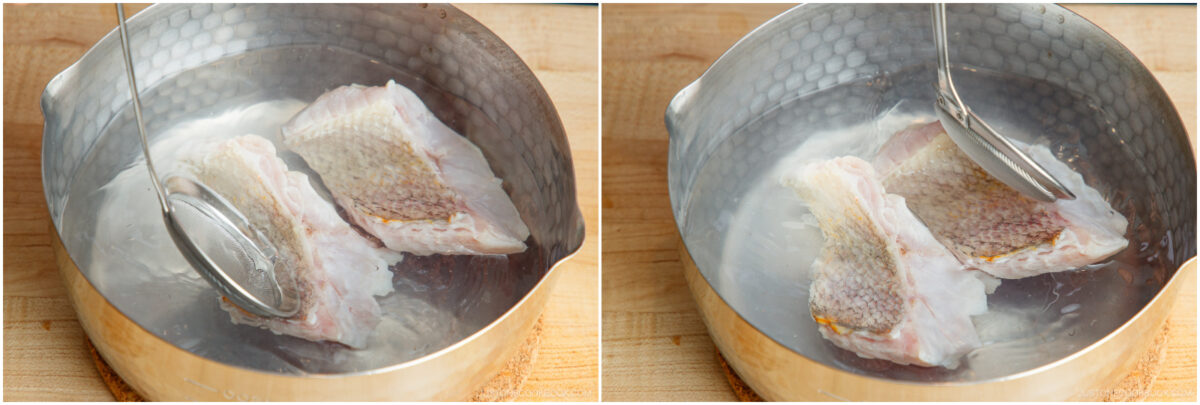
- As soon as the fish's surface turns white, remove it from the hot water. Place it in the ice water for about 10 seconds to cool and rinse off any residue. Then gently pat dry with clean paper towels. Discard the blanching water and quickly rinse the saucepan. Nami's Tip: This quick blanching step, called shimo-furi (霜降り), helps remove unwanted odors and surface proteins. Remember, you are not cooking the fish—just cleaning it for a better flavor and texture.

To Simmer
- Add the cold brew kombu dashi, hydrated kombu, and ¼ cup sake to the same saucepan. Gently place the fish fillets on top of the kombu, skin side up. Bring it to a gentle boil over medium heat. Nami's Tip: When you add sake and let it boil, the alcohol evaporates along with the fishy smell, leaving a mild, savory aroma behind.
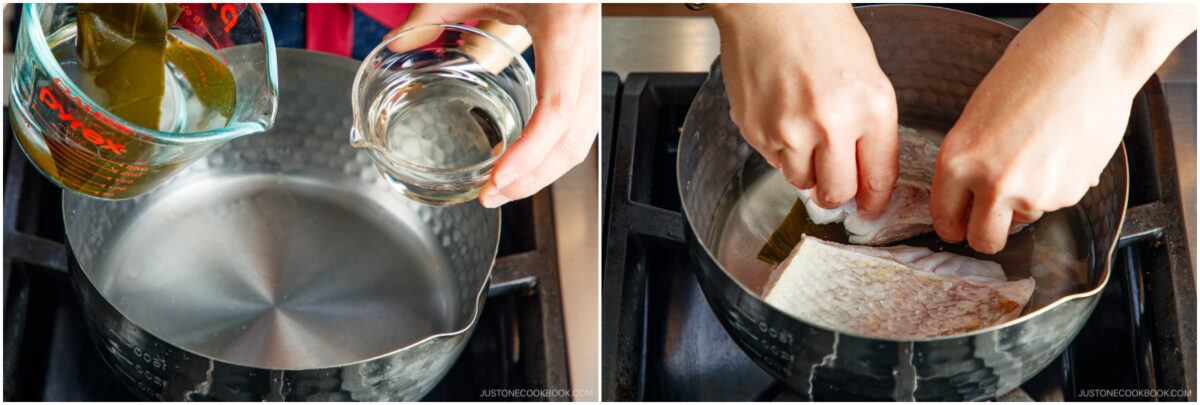
- Add the burdock root. Once simmering, skim off the scum and foam from the liquid's surface with a fine-mesh skimmer for a clean, clear sauce. Nami's Tip: Burdock root helps to remove odors, so add it from the beginning.
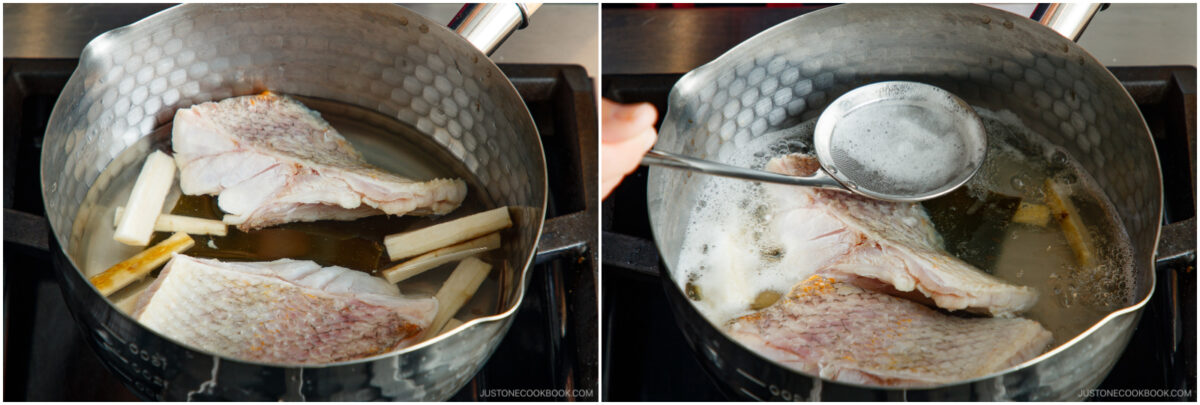
- Remove the kombu; you can use it in other recipes like homemade furikake. Now, add the ginger slices.
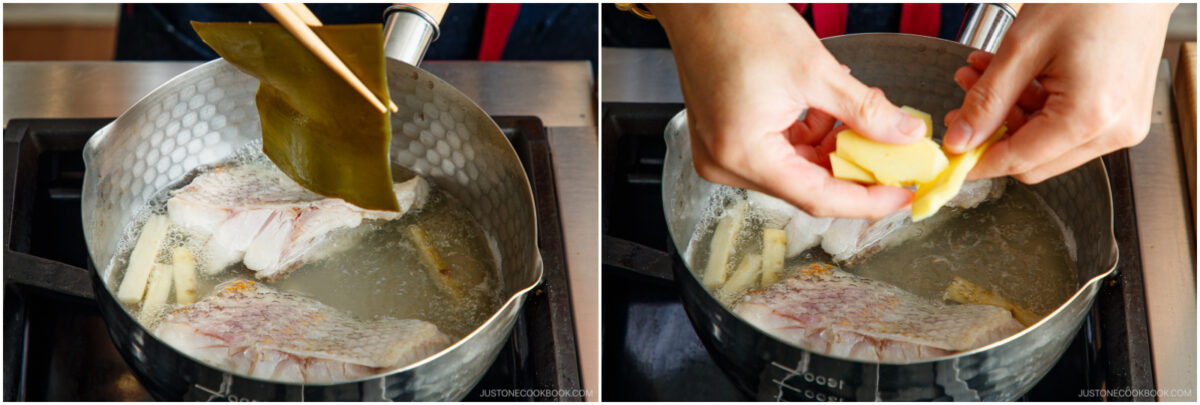
- Add ¼ cup mirin and 1½ Tbsp sugar, stirring the broth carefully with chopsticks to dissolve the sugar (careful not to break the fish). Nami's Tip: What about soy sauce? When salty ingredients are added, the sweetness does not penetrate the ingredients as easily, so we'll add soy sauce later.
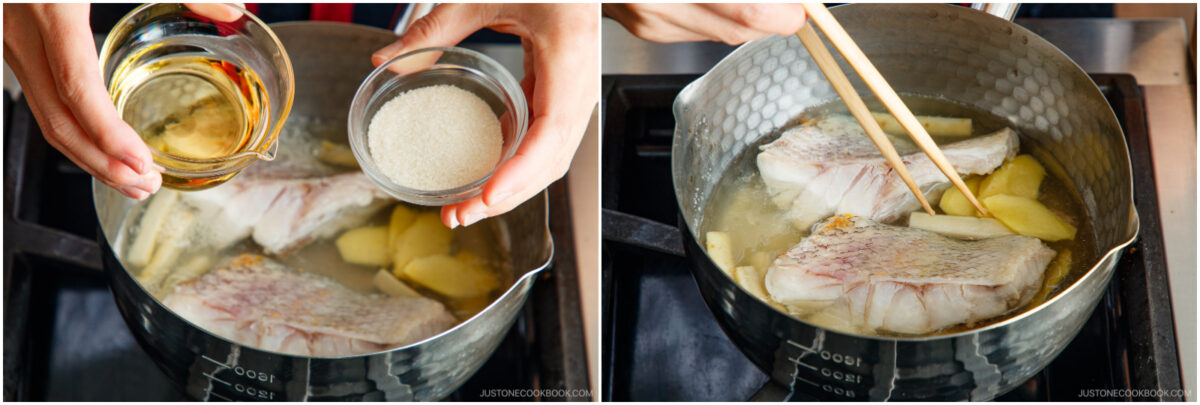
- Once simmering, reduce to medium-low heat, and keep a gentle simmer. Place an otoshibuta (drop lid) directly on the fish and set the timer for 5 minutes. Nami's Tip: The drop lid holds the fish in place so it doesn't break apart and evenly distributes the seasoned broth all over for better flavor absorption. Find one on JOC Goods or learn how to make otoshibuta at home with aluminum foil.
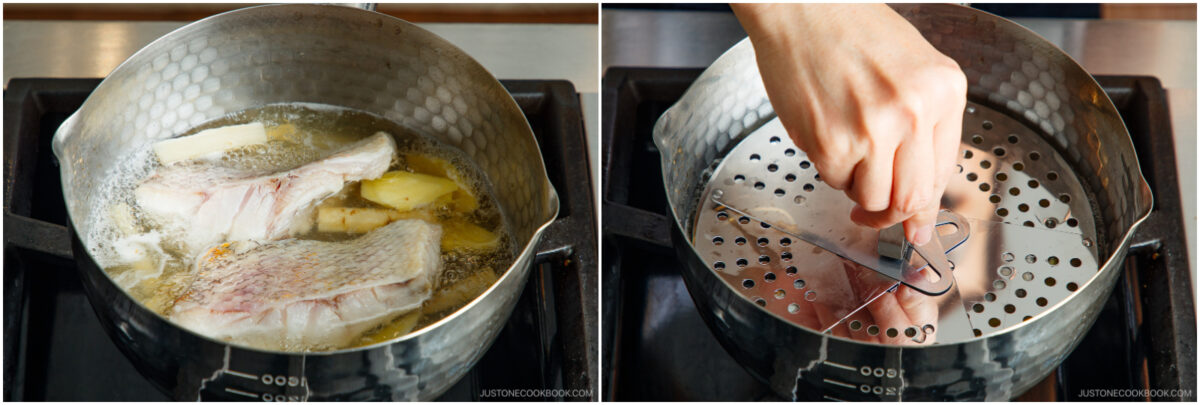
- When the timer is up (5 mins in), lift the drop lid and add 3 Tbsp soy sauce. Gently shake the saucepan to mix and place the otoshibuta (drop lid) back on the fish. Set the timer again for another 5 minutes and continue to simmer.
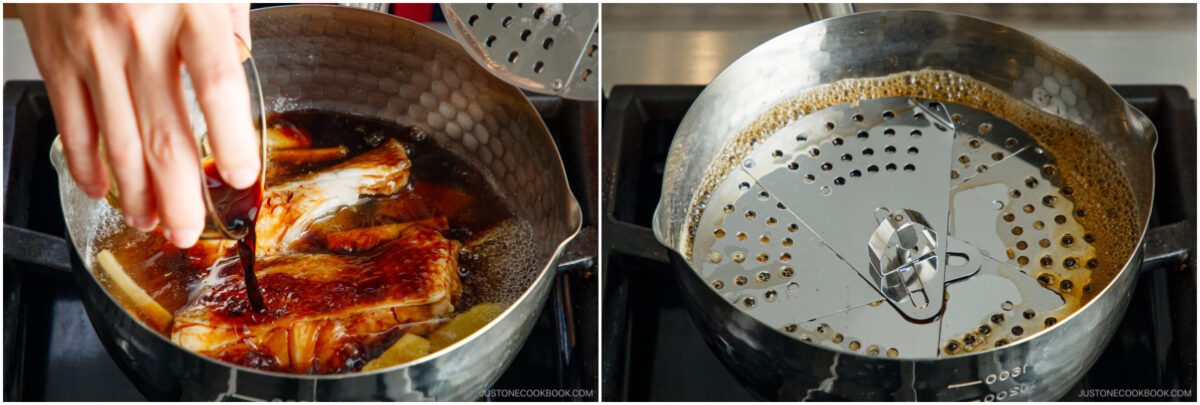
- During this time, open the drop lid and spoon the broth on the fish several times so the surface shines and the flavor infuses.
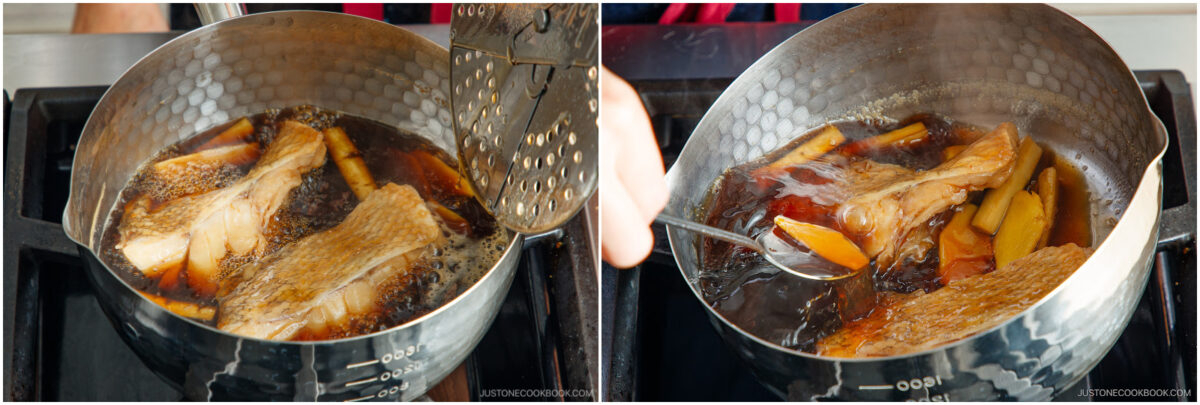
To Cool and Soak
- When the timer is up, turn off the heat. Set aside and let cool slowly in the seasoned liquid. Keep the lid on so the fish doesn't dry out. When ready to serve, reheat gently until warm, spooning the broth on the fish several times so the surface shines. Serve the fish and gobo drizzled with seasoned broth on individual plates. Nami's Tip: I highly recommend cooling the fish for a few hours or even overnight in the fridge to soak up the delicious seasonings.
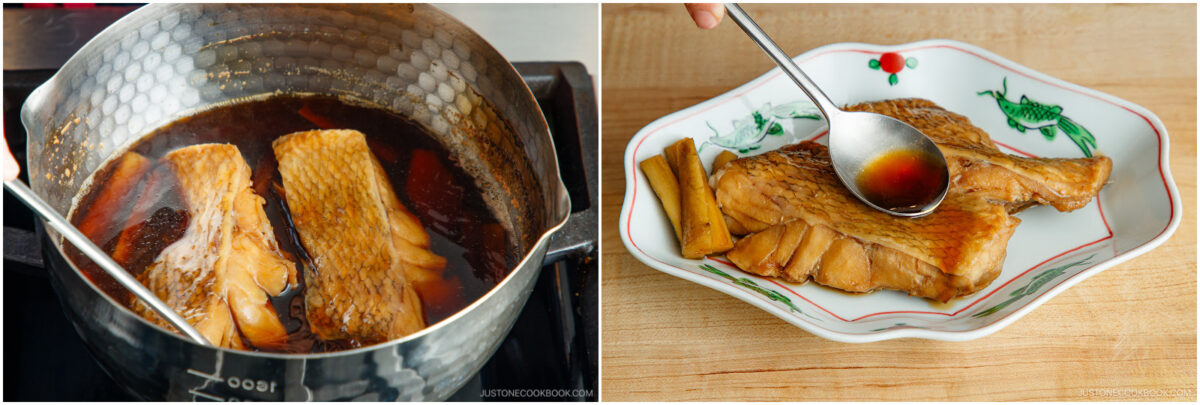
To Store
- Once completely cooled, transfer the leftovers to an airtight container and store in the refrigerator for up to 2–3 days or in the freezer for up to a month.
Nutrition
Did you make this recipe?
Tag @justonecookbook on Instagram so we can see your delicious creation!



